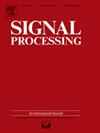Parametric GMM reconstruction for PET imaging from a reduced set of measurements
IF 3.4
2区 工程技术
Q2 ENGINEERING, ELECTRICAL & ELECTRONIC
引用次数: 0
Abstract
In this paper, we present a novel method for estimating the unknown parameters of the Gaussian Mixture Model (GMM) in Positron Emission Tomography (PET). Most PET imaging methods are based on reconstruction models defined by values on a pixel or voxel grid. Instead, we propose a continuous parametric GMM model. Typically, Expectation–Maximization (EM) iterations are used to obtain GMM parameters from a set of point-wise measurements. The challenge in PET reconstruction is that measurements are represented by lines instead of points. The goal is to estimate the unknown parameters of the Gaussian mixture directly from a relatively small set of lines. Estimation relies on two key facts: the marginal distribution theorem of the multivariate normal distribution and the properties of the marginal distribution of lines. We propose an iterative algorithm resembling the maximum-likelihood method to determine the unknown parameters. Results show that the estimated parameters closely match the true ones with great accuracy. This promising result indicates that a high-quality parametric reconstruction model can be obtained from lower dose measurements, making it directly suitable for further processing.
参数GMM重建PET成像从一组减少的测量
本文提出了一种估计正电子发射断层扫描(PET)中高斯混合模型(GMM)未知参数的新方法。大多数PET成像方法是基于由像素或体素网格上的值定义的重建模型。相反,我们提出了一个连续参数GMM模型。通常,期望最大化(EM)迭代用于从一组逐点测量中获得GMM参数。PET重建的挑战在于测量是用线而不是点来表示的。目标是直接从相对较小的一组直线中估计高斯混合物的未知参数。估计依赖于两个关键事实:多元正态分布的边际分布定理和直线边际分布的性质。我们提出了一种类似最大似然法的迭代算法来确定未知参数。结果表明,估计参数与真实参数吻合较好,具有较高的精度。这一有希望的结果表明,可以从低剂量测量中获得高质量的参数重建模型,使其直接适合进一步处理。
本文章由计算机程序翻译,如有差异,请以英文原文为准。
求助全文
约1分钟内获得全文
求助全文
来源期刊

Signal Processing
工程技术-工程:电子与电气
CiteScore
9.20
自引率
9.10%
发文量
309
审稿时长
41 days
期刊介绍:
Signal Processing incorporates all aspects of the theory and practice of signal processing. It features original research work, tutorial and review articles, and accounts of practical developments. It is intended for a rapid dissemination of knowledge and experience to engineers and scientists working in the research, development or practical application of signal processing.
Subject areas covered by the journal include: Signal Theory; Stochastic Processes; Detection and Estimation; Spectral Analysis; Filtering; Signal Processing Systems; Software Developments; Image Processing; Pattern Recognition; Optical Signal Processing; Digital Signal Processing; Multi-dimensional Signal Processing; Communication Signal Processing; Biomedical Signal Processing; Geophysical and Astrophysical Signal Processing; Earth Resources Signal Processing; Acoustic and Vibration Signal Processing; Data Processing; Remote Sensing; Signal Processing Technology; Radar Signal Processing; Sonar Signal Processing; Industrial Applications; New Applications.
 求助内容:
求助内容: 应助结果提醒方式:
应助结果提醒方式:


